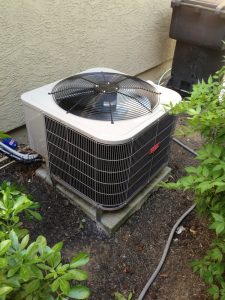
If the cost of running your air conditioner is getting out of hand, consider replacing it with a more efficient, variable-speed unit. Photo: AIS Heating & Air Conditioning (2017)
Imagine if your car only drove at one speed, regardless of whether you were in town or on the freeway, or if your stereo only had a single volume setting that couldn’t be adjusted. Sounds awful, right? Well, when it comes to your air conditioner, you may be dealing with an equivalent situation. In fact, the air conditioners found in many Bay Area homes only have one setting: full blast. Not surprisingly, these relics of cooling technology aren’t exactly the epitome of energy efficiency.
Fortunately, there’s a better option available: the variable-speed air conditioner. Unlike its single-speed predecessors, a variable-speed unit is able to incrementally adjust its power output in conjunction with changing climate conditions—and that’s just the beginning. Here are a few of the benefits a variable-speed air conditioner has to offer:
Improved energy efficiency
A variable-speed unit’s ability to intuitively modify its power output makes it extremely energy-efficient. Whereas a single-stage unit can only run at 100 percent power, a variable-speed unit can operate using as little as 35 percent of its power capacity. It doesn’t take a math whiz to understand this can save a substantial amount of energy, especially in the Bay Area, where extreme heat is more the exception than the rule. After all, while you may need your air conditioner running at full power on a 100-degree day, this isn’t the case when it’s 85 degrees.
A variable-speed air conditioner also prevents short cycling, which is when a unit frequently turns on and off. Single-stage air conditioners are notorious short cyclers: Since they only operate at full power, they cool things down too quickly, which signals the thermostat to shut things down before the room has a chance to fully absorb the conditioned air. When the temperature rises again soon after, the air conditioner turns on again, and so the cycle goes. This can get expensive, not least because an air conditioner’s compressor draws the most energy when it’s first turned on. In contrast, by running more continuously at lower power levels, a variable-speed unit minimizes these costly stops and starts.
Improved comfort
Because of its smooth, continuous operation, a variable-speed air conditioner lets homeowners enjoy a more consistent indoor climate, with fewer warm spots and lower humidity levels. It also allows for customized zoning, which gives you more control over which areas of your home are being cooled. Furthermore, variable-speed air conditioners reduce noise levels: Rather than turning on abruptly and blowing at full blast like a single-speed unit, a variable-speed unit’s motor gradually ramps up, resulting in a more tranquil aural ambience.
Improved indoor air quality
When an air conditioner runs, it isn’t just cooling the home, it’s also circulating and cleaning the air. Since a single-stage air conditioner runs less frequently (whether because of short cycling or being manually turned off to save energy), indoor air can become stale due to lack of circulation. In contrast, a variable-speed unit’s continuous operation results in a more refreshing indoor environment. Of course, to get the full benefit, you’ll need to change your air filter regularly, so don’t neglect this important maintenance step.
A variable-speed air conditioner may be more expensive than a single-speed unit, but the benefits it provides amount to a significant value. Not only will you see an investment return from the decrease in energy costs, you’ll also enjoy a more comfortable, fresh and clean home environment.
To find a Diamond Certified HVAC company that can help you with your cooling needs, visit www.diamondcertified.info.
